Testing the I_ab model
The I_ab model is the simplest two-state isomerization model
Contents
close all clear all
Here you will find all figures
figures_folder='I_ab_testing_figures';
Test Computation of Equilibrium Concentrations
Set some meaningful parameters
Rtotal=1; % Receptor concentration, M K_As=[0.25 0.5 0.667 1 2 3 4]; % Binding affinity constant % Set appropriate options for the model (see model file for details) model_numeric_solver='analytical' ; model_numeric_options='n/a'; concentrations_array=[]; for counter=1:length(K_As) % compute [concentrations species_names] = equilibrium_thermodynamic_equations.I_ab_model(... Rtotal, K_As(counter),... model_numeric_solver, model_numeric_options); % collect concentrations_array = [concentrations_array ; concentrations]; end
Plot
Figure_title= 'I_ab model'; X_range=[0 max(K_As)+0.1 ]; % extend X just a bit past last point Y_range=[0 Rtotal ]; % keep automatic scaling for Y % display figure figure_handle=equilibrium_thermodynamic_equations.plot_populations(... K_As, concentrations_array, species_names, Figure_title, X_range, Y_range); xlabel('Equilibrium constant','FontSize',14); % save it results_output.output_figure(figure_handle, figures_folder, 'Concentrations_plot');
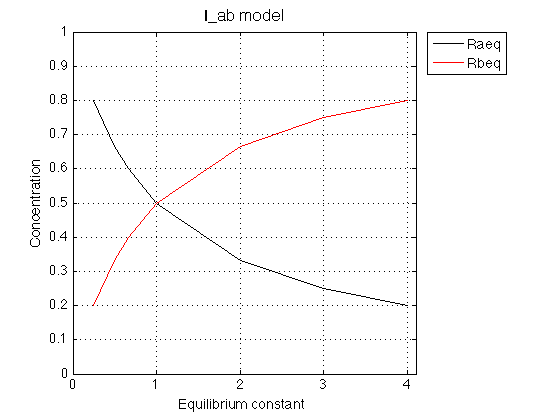
Observations
The ratio between Ra and Rb forms changes appropriately with K_A value.
Conclusion
The model equilibrium_thermodynamic_equations.I_ab_model() works well.
Test of NMR line shape calculations
We will generate line shapes for in conditions where we can expect specific patterns. We will plot a spectrum at a specific solution conditions (we will not use Series of datasets for simplicity).
Create NMR line shape dataset
Create data object for 1D NMR line shapes
test1=NMRLineShapes1D('Simulation','Test_1'); test1.set_active_model('I_ab-model', model_numeric_solver, model_numeric_options) test1.show_active_model() % to look up necessary parameters of the model
ans = Active model: Model 2: "I_ab-model" Model description "Two-state intramolecular isomerization, analytical" Model handle: line_shape_equations_1D.I_ab_model_1D Current solver: analytical Model parameters: 1: Rtotal 2: K_A 3: k_2_A 4: w0_Ra 5: w0_Rb 6: FWHH_Ra 7: FWHH_Rb 8: ScaleFactor
Set range for X to extend beyond resonances
w_min= -300;
w_max= 500;
datapoints=100; % Does not matter much because smooth curve is anyway calculated
test1.set_X(linspace(w_min, w_max, datapoints));
Set fixed plotting ranges for easier comparison If we do not set ranges they will be chosen automatically for each graph
test1.X_range=[w_min w_max]; % this sets display range in the plots test1.Y_range=[0 8e-5]; % this sets display range in the plots
Calculate ideal data: set noise RMSD to 0 for both X and Y
X_RMSD=0; Y_RMSD=0;
Test 1:
test_number=1; name='Slow exchange: equal populations, equal FWHH' % Use the same thermodynamic parameters as above. Add spectral and kinetic parameters: Rtotal=1e-3; K_A=1; % equilibrium constant k_2_A=10; % reverse rate constant , 1/s w0_Ra=300; % NMR frequency , 1/s w0_Rb=-100; % NMR frequency , 1/s FWHH_Ra=20; % line width at half height of the peak, 1/s FWHH_Rb=20; % line width at half height of the peak, 1/s ScaleFactor=3; % a multiplier for spectral amplitude (used only when fitting data) % compute equilbrium concentrations [concentrations species_names] = equilibrium_thermodynamic_equations.I_ab_model(... Rtotal, K_A,... model_numeric_solver, model_numeric_options); % plot line shapes parameters=[ Rtotal K_A k_2_A w0_Ra w0_Rb FWHH_Ra FWHH_Rb ScaleFactor ]; test1.simulate_noisy_data(parameters, X_RMSD, Y_RMSD); figure_handle=test1.plot_simulation(name); results_output.output_figure(figure_handle, figures_folder, sprintf('Test_results.%d', test_number));
name = Slow exchange: equal populations, equal FWHH
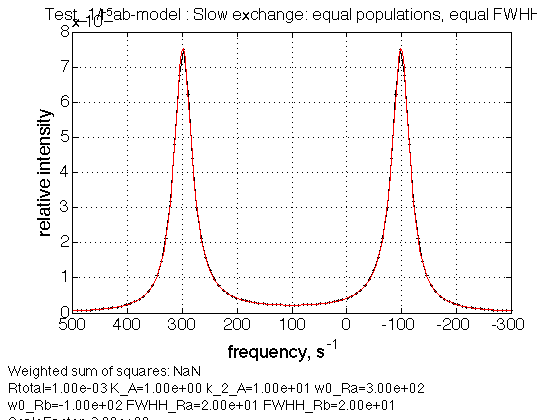
Observations
We see a correct 1:1 intensity ratio, peak positioning and the line widths
Test 2
test_number=2; name='Slow exchange: equal populations, different FWHH'; % Use the same thermodynamic parameters as above. Add spectral and kinetic parameters: Rtotal=1e-3; K_A=1; % equilibrium constant k_2_A=10; % reverse rate constant , 1/s w0_Ra=300; % NMR frequency , 1/s w0_Rb=-100; % NMR frequency , 1/s FWHH_Ra=20; % line width at half height of the peak, 1/s FWHH_Rb=60; % line width at half height of the peak, 1/s ScaleFactor=3; % a multiplier for spectral amplitude (used only when fitting data) % compute equilbrium concentrations [concentrations species_names] = equilibrium_thermodynamic_equations.I_ab_model(... Rtotal, K_A,... model_numeric_solver, model_numeric_options); % plot line shapes parameters=[ Rtotal K_A k_2_A w0_Ra w0_Rb FWHH_Ra FWHH_Rb ScaleFactor ]; test1.simulate_noisy_data(parameters, X_RMSD, Y_RMSD); figure_handle=test1.plot_simulation(name); results_output.output_figure(figure_handle, figures_folder, sprintf('Test_results.%d', test_number));
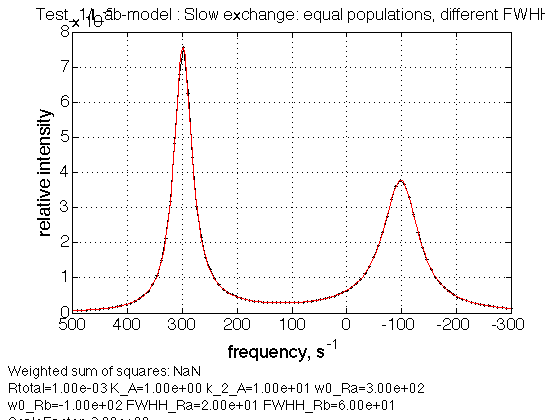
Observations
We see an expected broadening of Rb.
Test 3
test_number=3; name='Slow exchange: unequal populations, same FWHH'; % Use the same thermodynamic parameters as above. Add spectral and kinetic parameters: Rtotal=1e-3; K_A=3; % equilibrium constant k_2_A=10; % reverse rate constant , 1/s w0_Ra=300; % NMR frequency , 1/s w0_Rb=-100; % NMR frequency , 1/s FWHH_Ra=20; % line width at half height of the peak, 1/s FWHH_Rb=20; % line width at half height of the peak, 1/s ScaleFactor=2; % a multiplier for spectral amplitude (used only when fitting data) % compute equilbrium concentrations [concentrations species_names] = equilibrium_thermodynamic_equations.I_ab_model(... Rtotal, K_A,... model_numeric_solver, model_numeric_options); % plot line shapes parameters=[ Rtotal K_A k_2_A w0_Ra w0_Rb FWHH_Ra FWHH_Rb ScaleFactor ]; test1.simulate_noisy_data(parameters, X_RMSD, Y_RMSD); figure_handle=test1.plot_simulation(name); results_output.output_figure(figure_handle, figures_folder, sprintf('Test_results.%d', test_number));
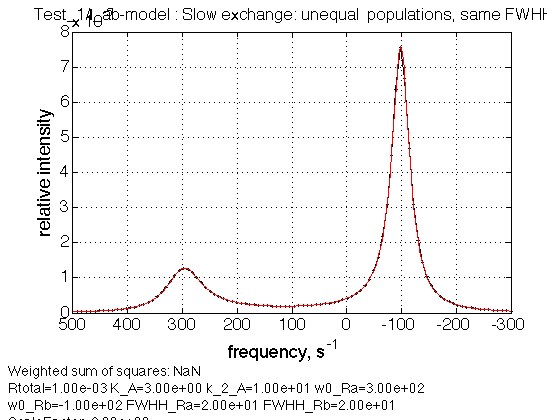
Observations
We see an expected preferential broadening of Ra. Therefore, intensity ratio is > K_A
Test 4
test_number=4; name='Fast exchange: unequal populations, same FWHH'; % Use the same thermodynamic parameters as above. Add spectral and kinetic parameters: Rtotal=1e-3; K_A=3; % equilibrium constant k_2_A=500; % reverse rate constant , 1/s w0_Ra=300; % NMR frequency , 1/s w0_Rb=-100; % NMR frequency , 1/s FWHH_Ra=20; % line width at half height of the peak, 1/s FWHH_Rb=20; % line width at half height of the peak, 1/s ScaleFactor=2; % a multiplier for spectral amplitude (used only when fitting data) % compute equilbrium concentrations [concentrations species_names] = equilibrium_thermodynamic_equations.I_ab_model(... Rtotal, K_A,... model_numeric_solver, model_numeric_options); % plot line shapes parameters=[ Rtotal K_A k_2_A w0_Ra w0_Rb FWHH_Ra FWHH_Rb ScaleFactor ]; test1.simulate_noisy_data(parameters, X_RMSD, Y_RMSD); figure_handle=test1.plot_simulation(name); results_output.output_figure(figure_handle, figures_folder, sprintf('Test_results.%d', test_number));
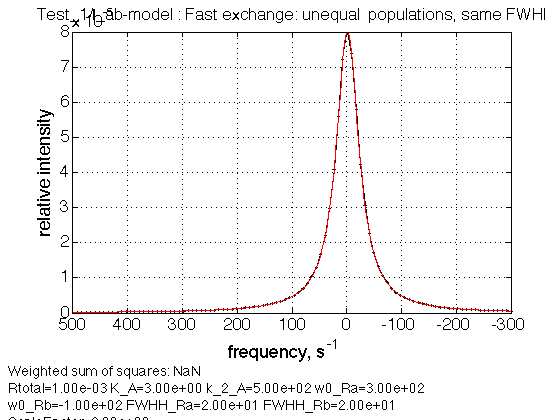
Observations
We see an expected averaged peak at 3:1 position between the frequencies of species
Conclusions
The I_ab model works as expected.